目录
接上一篇:C++类与对象(2)—构造函数&析构函数

一、拷贝构造函数
1、定义
拷贝构造函数:只有单个形参,该形参是对本类类型对象的引用(一般常用const修饰),在用已存
在的类类型对象创建新对象时由编译器自动调用。
2、特征
- 拷贝构造函数是构造函数的一个重载形式。
- 拷贝构造函数的参数只有一个且必须是类类型对象的引用,使用传值方式编译器直接报错,因为会引发无穷递归调用。

class Date
{
public:
Date(int year = 1900, int month = 1, int day = 1)
{
_year = year;
_month = month;
_day = day;
}
// 拷贝构造
Date(const Date& d)
{
_year = d._year;
_month = d._month;
_day = d._day;
}
void Print()
{
cout << _year << "/" << _month << "/" << _day << endl;
}
private:
int _year;
int _month;
int _day;
};
int main()
{
date d1(2023, 2, 3);
date d2(d1);
d1.Print();
d2.Print();
return 0;
}输出结果如下,我们可以看到d1的值成功复制给d2.
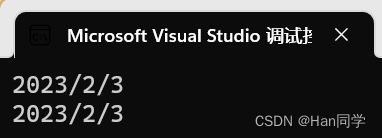
如果不加&引用符号,编译器会报错。
![]()
使用拷贝构造也可以用这种方式:
Date d3 = d1;3、内置与自定义类型
- 内置类型的拷贝和传参,编译器可以直接拷贝,
- 自定义类型的拷贝和传参,需要调用拷贝构造。
为什么需要拷贝构造呢?
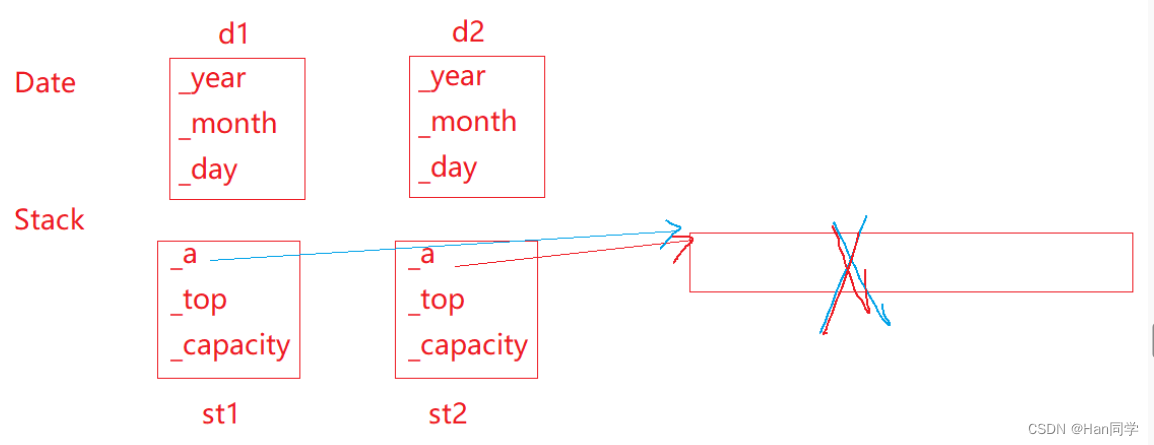
用栈实现队列的时候,可能一会对st1进行析构一会对st2进行析构,成员变量指针_a指向的空间不能析构两次,而且如果分别对st1和st2赋初值,后赋值的会覆盖先赋值的数据。所以就要求它们不能指向同一块空间,各自要有各自的空间,所以C++规定:自定义类型的拷贝和传参,需要调用拷贝构造,对于栈这种需要深拷贝的拷贝构造(后续学习),现阶段只需要知道需要拷贝构造即可。
自定义类型传参:
class Date
{
public:
Date(int year = 1900, int month = 1, int day = 1)
{
_year = year;
_month = month;
_day = day;
}
// 拷贝构造
// Date d2(d1);
Date(Date& d)
{
_year = d._year;
_month = d._month;
_day = d._day;
}
private:
int _year;
int _month;
int _day;
};
// 传值传参
void Func1(Date d)
{
}
// 传引用传参
void Func2(Date& d)
{
}
// 传指针
void Func3(Date* d)
{
}
int main()
{
Date d1(2023, 2, 3);
Func1(d1);
//Func2(d1);
//Func3(&d1);
return 0;
}使用Func1传值传参 :

在Func1(d1)处按F11会直接跳转到拷贝构造。
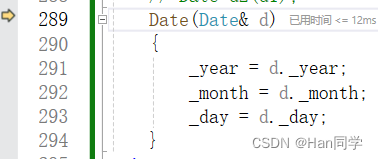
拷贝构造结束会进行Func1函数。

如果用Func2引用传参,就不需要拷贝构造了。

直接跳转Func2函数。
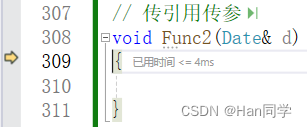
此外还可以使用以前C语言中常用的指针传参,但这种方法有点啰嗦。
Func3(&d1);4、const修饰参数
拷贝构造一般会加const,如果不加,比如下面的情况,赋值方向反了,会导致原数据变成随机值。
Date(Date& d)
{
d._year = _year;
d._month = _month;
d._day = _day;
}加上const可以避免拷贝方向错误时,原数据被修改,所以一般习惯参数前加上const。
Date(const Date& d)
{
_year = d->_year;
_month = d->_month;
_day = d->_day;
}此外,如果被拷贝的变量是被const修饰,如果拷贝构造的参数不被const修饰,会造成引用的权限扩大,所以一定要用const修饰参数。
5、默认生成
浅拷贝
若未显式定义,编译器会生成默认的拷贝构造函数。 默认的拷贝构造函数对象按内存存储按
字节序完成拷贝,这种拷贝叫做浅拷贝,或者值拷贝。
class Date
{
public:
Date(int year = 1, int month = 1, int day = 1)
{
_year = year;
_month = month;
_day = day;
}
void Print()
{
cout << _year << "-" << _month << "-" << _day << endl;
}
private:
int _year;
int _month;
int _day;
};
int main()
{
Date d1(2023, 11, 20);
d1.Print();
Date d2(d1);
d2.Print();
return 0;
}通过输出结果我们可以发现,没写拷贝函数,编译器会自动对内置类型拷贝。
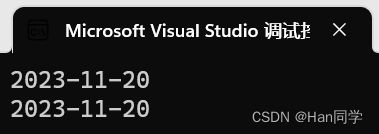
编译器生成的默认拷贝构造函数已经可以完成字节序的值拷贝了,还需要自己显式实现吗?
当然像日期类这样的类是没必要的。
如果是自定义类型呢?程序会怎么处理?
typedef int DataType;
class Stack
{
public:
Stack(size_t capacity = 10)
{
cout << "Stack(size_t capacity = 10)" << endl;
_array = (DataType*)malloc(capacity * sizeof(DataType));
if (nullptr == _array)
{
perror("malloc申请空间失败");
exit(-1);
}
_size = 0;
_capacity = capacity;
}
void Push(const DataType& data)
{
// CheckCapacity();
_array[_size] = data;
_size++;
}
~Stack()
{
cout << "~Stack()" << endl;
if (_array)
{
free(_array);
_array = nullptr;
_capacity = 0;
_size = 0;
}
}
private:
DataType* _array;
size_t _size;
size_t _capacity;
};
int main()
{
Stack st1;
Stack st2(st1);
return 0;
} 输出后程序会报错: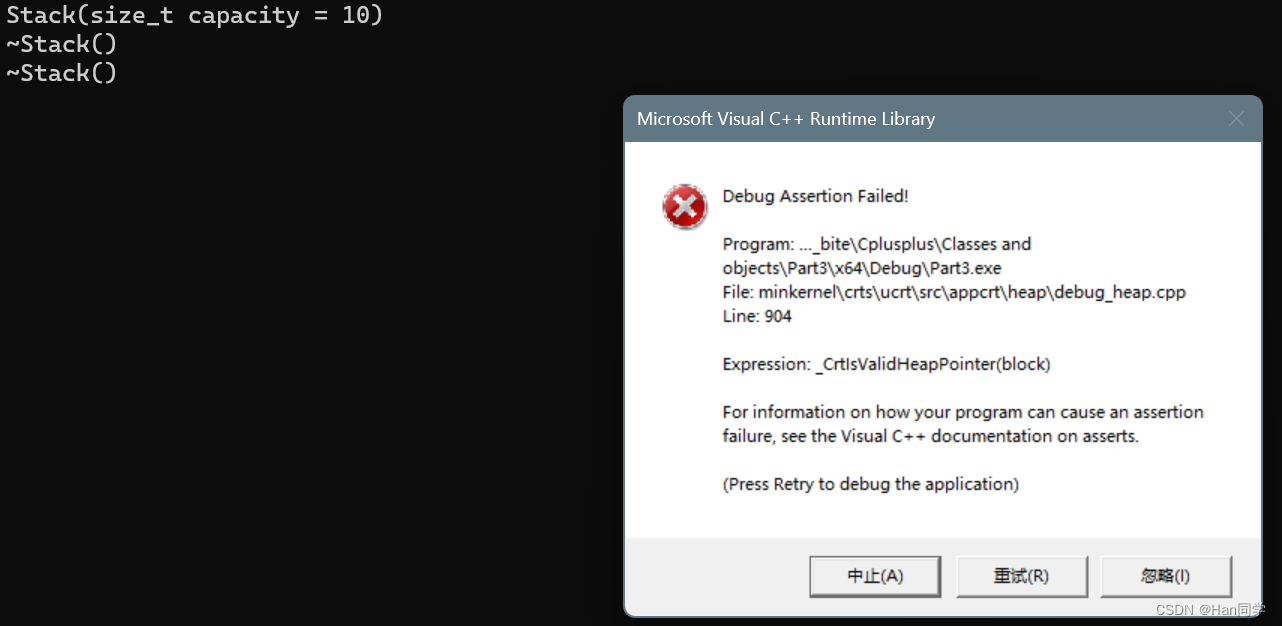
如果按照内置类型的方式对自定义类型进行拷贝, 两个Stack类的变量st1和st2的成员变量*array都指向同一块空间, 这样会导致两个问题:
这样会导致两个问题:
- 插入和删除数据会互相影响,比如st1先插入三个数据,st1的size为3,这时st2要插入数据,但st2的size为0,如果插入数据则会造成st1插入的数据被覆盖;同时,在析构st1时,对st1的空间进行释放,由于st1和st2的成员变量*array都指向同一块空间,这时st2再插入数据会造成对野指针的访问。
- 程序销毁*_array的空间时,会析构两次,程序会崩溃。
深拷贝
这时只有深拷贝才能解决自定义类型的拷贝构造。
Stack(const Stack& st)
{
_array = (DataType*)malloc(sizeof(DataType) * st._capacity);
if (_array == nullptr)
{
perror("malloc fail");
exit(-1);
}
memcpy(_array, st._array, sizeof(DataType) * st._size);
_size = st._size;
_capacity = st._capacity;
}st2成功实现了拷贝构造,st2与st1的地址不同,它们不在指向同一空间了。

什么时候需要自己实现拷贝构造?
- 当自己实现了析构函数释放空间,就需要实现拷贝构造。
class MyQueue
{
public:
// 默认生成构造
// 默认生成析构
// 默认生成拷贝构造
private:
Stack _pushST;
Stack _popST;
int _size = 0;//缺省值处理
};- 两个Stack类型的成员变量初始化调用默认生成构造,销毁调用它的析构函数,拷贝使用它的拷贝构造。
- 整型变量_size初始化通过缺省值处理,内置类型出磊之后会自动销毁,不需要析构处理,可以使用默认生成拷贝构造。
6、总结
拷贝构造函数典型调用场景:
- 使用已存在对象创建新对象
- 函数参数类型为类类型对象
- 函数返回值类型为类类型对象
默认生成拷贝构造:
- 内置类型完成浅拷贝/值拷贝(按字节一个一个拷贝)
- 自定义类型去调用这个成员的拷贝构造。
为了提高程序效率,一般对象传参时,尽量使用引用类型,返回时根据实际场景,能用引用
尽量使用引用。
二、运算符重载
1、定义
C++为了增强代码的可读性引入了运算符重载,运算符重载是具有特殊函数名的函数,也具有其返回值类型,函数名字以及参数列表,其返回值类型与参数列表与普通的函数类似。
- 函数名字为:关键字operator后面接需要重载的运算符符号。
- 函数原型:返回值类型 operator操作符(参数列表)
注意:
- 不能通过连接其他符号来创建新的操作符:比如operator@
- 重载操作符必须有一个类类型参数
- 用于内置类型的运算符,其含义不能改变,例如:内置的整型+,不 能改变其含义
- 作为类成员函数重载时,其形参看起来比操作数数目少1,因为成员函数的第一个参数为隐藏的this
- .* :: sizeof ? : . 注意以上5个运算符不能重载。
我们通过代码一点一点理解:
class Date
{
public:
Date(int year = 1900, int month = 1, int day = 1)
{
_year = year;
_month = month;
_day = day;
}
//private:
int _year;
int _month;
int _day;
};
//运算符重载
bool operator==(const Date& d1, const Date& d2)
{
return d1._year == d2._year
&& d1._month == d2._month
&& d1._day == d2._day;
int main()
{
Date d1(2023, 1, 1);
Date d2(2023, 1, 1);
//下面两种使用方式均可
operator==(d1, d2);
d1 == d2;//编译器会转换成去调用operator==(d1,d2);
return 0;
}如果要输出函数返回值,方式如下:
cout << (d1 == d2) << endl;//必须加括号,保证优先级
cout << operator==(d1, d2) << endl;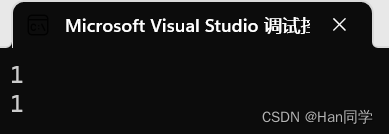
这里会发现,如果运算符重载成全局的就需要成员变量是公有的,否则会报错。
那么问题来了,封装性如何保证?
我们可以选择后面学习的友元处理,现阶段直接把运算符重载函数重载成成员函数即可。
2、判断是否相等
class Date
{
public:
Date(int year = 1900, int month = 1, int day = 1)
{
_year = year;
_month = month;
_day = day;
}
//运算符重载
// bool operator==(Date* this, const Date& d)
// 这里需要注意的是,左操作数是this,指向调用函数的对象
bool operator==(const Date& d)
{
return _year == d._year
&& _month == d._month
&& _day == d._day;
}
private:
int _year;
int _month;
int _day;
};
int main()
{
Date d1(2023, 1, 1);
Date d2(2023, 1, 1);
//operator内置只能使用这种形式(d1 == d2,
cout << (d1 == d2) << endl;
return 0;
}3、比较大小
bool operator<(const Date& d)
{
if (_year < d._year)
{
return true;
}
else if (_year == d._year && _month < d._month)
{
return true;
}
else if (_year == d._year && _month == d._month && _day < d._day)
{
return true;
}
else
{
return false;
}
}还可以写成这种简便形式,但上述较长的方式更直观。
return _year < d._year
|| (_year == d._year && _month < d._month)
|| (_year == d._year && _month == d._month && _day < d._day);判断小于等于我们可以借助隐藏的this指针,使用运算符重载嵌套的方式,在判断小于等于中分别调用判断小于和判断等于的运算符重载。
// d1 <= d2
bool operator<=(const Date& d)
{
return *this < d || *this == d;
}
同理,判断大于、大于等于和不等于,我们也对上面的运算符重载进行复用。
// d1 > d2
bool operator>(const Date& d)
{
return !(*this <= d);
}
bool operator>=(const Date& d)
{
return !(*this < d);
}
bool operator!=(const Date& d)
{
return !(*this == d);
}4、赋值
- 内置类型成员变量是直接赋值的,而自定义类型成员变量需要调用对应类的赋值运算符重载完成赋值,所以日期类就不需要写赋值运算符重载函数,而类似用栈实现队列则需要。
- 如果类中未涉及到资源管理,赋值运算符是否实现都可以;一旦涉及到资源管理则必须要实现。
- 赋值运算符在类中不显式实现时,编译器会生成一份默认的,此时用户在类外再将赋值运算符重载为全局的,就和编译器生成的默认赋值运算符冲突了,故赋值运算符只能重载成成员函数。
class Date
{
public:
Date(int year = 1900, int month = 1, int day = 1)
{
_year = year;
_month = month;
_day = day;
}
void Print()
{
cout << _year << "/" << _month << "/" << _day << endl;
}
void operator=(const Date& d)
{
_year = d._year;
_month = d._month;
_day = d._day;
}
private:
int _year;
int _month;
int _day;
};
int main()
{
Date d1(2023, 6, 6);
Date d2(1, 1, 1);
d2 = d1;
d1.Print();
d2.Print();
return 0;
}operator=就是我们的赋值运算符重载,如果我们不使用引用传值,那自定义类型会调用拷贝构造,我们使用引用传值,就避免了这些拷贝操作。

如果三个数赋值呢?
d3 = d2 = d1;根据赋值操作符的右结合性,d1赋值给d2需要一个返回值才能对d3赋值。
返回值使用引用返回,避免传值返回过程中,创建临时变量和不必要的拷贝。
Date& operator=(const Date& d)
{
_year = d._year;
_month = d._month;
_day = d._day;
return *this;
}如果自己给自己赋值呢?那就可以不进行赋值操作了,我们添加一个判断即可。
Date& operator=(const Date& d)
{
if (this != &d)
{
_year = d._year;
_month = d._month;
_day = d._day;
}
return *this;
}上面就是赋值运算符的完整版了。